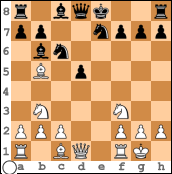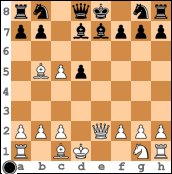The Tarrasch Variation is named after Siegbert Tarrasch. This move was particularly popular during the late 1970s and early 1980s when Anatoly Karpov used it to great effect. It is still played today by players seeking a small, safe advantage.
The move differs from 3.Nc3 in several respects: it doesn't block the path of White's c pawn, which means he can play c3 at some stage to support the d4 pawn; and it avoids the Winawer Variation because 3...Bb4 can be met with 4.c3 when Black has wasted a move (he has to retreat his bishop).
3...c5 4.exd5 exd5, a staple of many old Karpov-Korchnoi battles, usually leads to Black having an isolated queen's pawn (see Isolated pawn). The main line continues 5.Ngf3 Nc6 6.Bb5 Bd6 7.0-0 Nge7 8.dxc5 Bxc5 9.Nb3 Bb6 with a position where if White can neutralize the activity of Black's pieces in the middlegame, he will have a slight endgame advantage. Another possibility for White is 5.Bb5+ Bd7 (5...Nc6 is also possible) 6.Qe2+ Be7 7.dxc5 to trade off the bishops and make it more difficult for Black to regain the pawn.


3...c5 4.exd5 Qxd5!? is an important alternative for Black. The idea is to trade his c- and d-pawns for White's d- and e-pawns, leaving Black with an extra centre pawn. This constitutes a slight structural advantage, but in return White gains time for development by harassing Black's queen. This interplay of static and dynamic advantages is the reason why this line has become popular in the last decade. Play usually continues 5.Ngf3 cxd4 6.Bc4 Qd6 7.0-0 Nf6 (preventing 8.Ne4) 8.Nb3 Nc6 9.Nbxd4 Nxd4, and here White may stay in the middlegame with 10.Nxd4 or offer the trade of queens with 10.Qxd4.
While the objective of 3...c5 was to break open the centre, 3...Nf6 aims to close it. After 4.e5 Nfd7 5.Bd3 c5 6.c3 Nc6 (6...b6 intends ...Ba6 next to get rid of Black's "bad" light-squared bishop, a recurrent idea in the French) 7.Ne2 (leaving f3 open for the queen's knight) 7...cxd4 8.cxd4 f6 9.exf6 Nxf6 10.Nf3 Bd6 Black has freed his pieces at the cost of having a backward pawn on e6. White may also choose to preserve his pawn on e5 by playing 4.e5 Nfd7 5.c3 c5 6.f4 Nc6 7.Ndf3, but his development is slowed as a result.
3.Nd2 Nc6 is known as the Guimard Variation: after 4.Ngf3 Nf6 5.e5 Nd7 Black will exchange off White's cramping e-pawn next move by ...f6. However, Black does not exert any pressure on d4 because he cannot play ...c5, so White should maintain a slight advantage.
A fashionable line among top GMs in recent years is 3...Be7!?, an odd-looking move which aims to prove that every White move now has its drawbacks, e.g. after 4.Ngf3 Nf6 5.e5 Nfd7 White cannot now play f4, whereas 4.Bd3 c5 5.dxc5 Nf6 and 4.e5 c5 5.Qg4 Kf8!? lead to obscure complications. Amazingly, 3... h6?!, with a similar rationale, has also gained some adventurous followers in recent years, including GM Alexander Morozevich. Another rare line is 3...a6, the idea being to deny White's light-square bishop use of b5 before playing ...c5.
Tarrasch, 3 ...Nc6 4 c3 ...f5
keres_petrosian_1950.pgn
Tarrasch, 3 ...a6 4 Nf3 ...c5
ivanchuk_dolmatov_1986.pgn
Tarrasch 3 ...c5 4 Nf3 ...Nc6
short_korchnoi_1987.pgn
Tarrasch 3 ...c5 4 Nf3 ...Nc6
karpov_korchnoi_1978.pgn
Tarrasch, 3 ...Be7 4 Ngf3 (exd5 line)
ponomariov_morozevich_1997.pgn
Tarrasch, 3 ...Be7 4 Ngf3 (e5 line)
van_der_wiel_korchnoi_1993.pgn
Tarrasch, 3 ...Be7 4 Bd3 (dxc5 line)
shulman_morozevich_1998.pgn
No comments:
Post a Comment